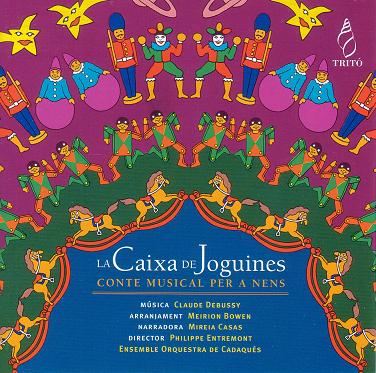MEIRION BOWEN - Debussy: La boite à joujoux (1913) New version by Meirion Bowen (completed October 1998)
Debussy's ballet-pantomime for children, La boite à joujoux (The Box of Toys) was the composer's last substantial work for the theatre, completed in October 1913. It originated as an illustrated story by the artist Andrew Hellé, a specialist in children's books. Hellé converted this into a ballet scenario, for which Debussy agreed to write the music. The composition of the piano score was partly inspired by the composer's seven-year-old daughter, Chouchou, her toys and dolls.
The published piano score, embodying colourful, delightfully playful illustrations and a commentary on the action, offers a good pointer as to its character. In Debussy's own words, the plot - a simple triangular love story - runs as follows: 'A cardboard soldier falls in love with a doll; he seeks to prove this to her, but she betrays him with Polichinelle. The soldier learns of her affair and terrible things begin to happen: a battle between wooden soldiers and polichinelles. In brief, the lover of the beautiful doll is gravely wounded during the battle. The doll nurses him and...they all live happily ever.'
Debussy called the work a 'pantomime', implying a varied entertainment without spoken dialogue. He also had his own idea as to how it should look: 'You see it is simplicity itself - even childish!...The characters must retain their angular movements, their burlesque appearance as cardboard cut-outs, without which the work would become meaningless.' He also commented that 'only marionettes will be able to convey the meaning of the text and expression of the music.'
In consequence, he found himself in conflict with the work's first director, at the Opéra-Comique, P-B. Gheusi, whose conception he regarded as too grandiose. The First World War then intervened and the production never off the ground until after Debussy's death. At Gheusi's request, the scoring was completed by André Caplet and used for the premiere at the short-lived Theatre-Lyrique de Vaudeville on 10 December 1919. Although the work was described by Debussy as a 'ballet for children', adult dancers had ultimately to be used for practical reasons and this practice has been followed in the very few subsequent stagings. Debussy's notion of using marionettes was realised first in 1962 in Utrecht, then at the Queen Elizabeth Hall, London, by the Little Angel Marionette Theatre: in each, the original solo piano version was used (Daniel Baremboim played it in the London production).
The music of La boite à joujoux, which lasts 40 minutes, is delicate, witty and subtle, full of references to popular songs, well-known classical themes and allusions to Debussy's own compositions. Although there are some notable parodies - e.g. of Gounod's Soldier's Chorus and Mendelssohn's Wedding March - the score is never vulgar or bombastic. At one point there is an exotic solo woodwind arabesque which Debussy claimed in a footnote was 'an old Hindu chant still used today in the taming of elephants'.
What makes it all hang together is the recurrent use of sharply contrasted motifs for the three main characters: a reveille-type bugle call for the soldier, a delicious waltz-tune for the doll and a strident, angular motif in major seconds for Polichinelle. The reasons for its neglect lie partly with Caplet's orchestration, which militates against the intimate character of the piece and whose choice of instrumental solos is often inept. The narrative of the ballet also needs considerable fleshing out to become convincing.
Meirion Bowen's new arrangement makes it possible now to present the work in the concert-hall, with marionettes or live dancers.
The scoring is for 15 players:
Flute (doubling piccolo)
Oboe (doubling cor anglais)
2 Clarinets (second doubling Bass-Clarinet)
Bassoon
Horn
Trumpet
Harp
Percussion (1 player: side-drum, bass drum with pedal, hi-hat cymbal, suspended cymbal, military drum, castanets, tambourine, glockenspiel, rattle, crotale, triangle, large tam-tam)
2 Violins
1 Viola
1 Cello
1 Contrabass
For the concert-hall, a narration - written in collaboration with the Canadian writer Mark Kilfoyle - has been added and this was first performed on February 25, at the Wigmore Hall, London, by the Nash Ensemble conducted by Diego Masson, with Francois le Roux as narrator. (This narration is intended for an adult audience; a version suitable for children will also be available.)
Trito Edicions in Barcelona have released a CD recording of La boîte à joujoux, with a narration in Catalan.
The recording is part of a series of CDs of musical stories for children. The disc is entitled La Caixa de Joguines: Conte Musical per a Nens. Mireia Casas is the narrator and the Ensemble Orquestra de Cadaquès is conducted by Philippe Entremont.

For sound-bytes from this recording, please go to the Catalan section.

© Meirion Bowen (1998)
Top
